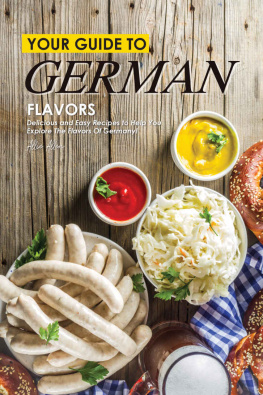 ABOUT THE AUTHOR
ABOUT THE AUTHOR
_______________________________________
M IMI S HERATON traveled throughout Germany over a two-year period to gather authentic material for this book, which has become the classic in its field, and she has since been back many times to keep it up-to-date. She is, arguably, our foremost restaurant critic, and, because of her candor, the most controversial and respected. Longstanding food critic for The New York Times, Time, and Cond Nast Traveler, she has traveled all over the world gathering information on food, crafts, and interior design for publications such as Vanity Fair, Esquire, Vogue, Mademoiselle, and Town & Country. She is now a contributing editor to New Woman. She won a JCPenney-University of Missouri prize for journalism for articles in New York magazine and a Front Page Award for work in The New York Times.
Born in Brooklyn and a graduate of New York University, where she received a degree in journalism and marketing, Ms. Sheraton studied interior decorating at the New York School of Interior Design, and cooking in various places, including Le Cordon Bleu in Paris, and with private teachers in Bangkok, Istanbul, and Beirut. For many years she was on the staff of Seventeen, Good Housekeeping, and House Beautiful.
Ms. Sheraton loves to photograph foreign food markets, and collects exotic cookware and junk antiques. She and her husband live in a Greenwich Village town house. In addition to four New York City restaurant guidebooks, she wrote The Seducers Cookbook, Visions of Sugarplums, From My Mothers Kitchen, and City Portraits, a travel guide to sixty of the worlds great cities. She also served as the historical foods consultant on The Horizon Cookbook. Her latest cookbook, The Whole World Loves Chicken Soup, received both the James Beard Foundation Award and the Julia Child/IACP Award.
CHAPTER
I
Appetizers and Light Snacks
(Vorspeisen und Zwischengerichte)

Unlike the Mediterraneans and Scandinavians, who like their appetizer courses to consist of little bits of many things (hors doeuvre varis, antipasto, the Greek, Turkish and Arabic meze, and smrgsbord), the Germans prefer to concentrate on one single dish for their Vorspeiseliterally, before food. Usually, it is a relatively expensive food item, something that will add a luxurious accent to the meal that follows, and it always has a piquant flavor that will whet the appetite. Vorspeise specialties are so delicious and so attractively arranged and garnished, that it is easy to get carried away and eat too much of this first course. Remember that portions should be large enough to take the edge off ravenous appetites, but small enough to leave room for the rest of the meal. Most of the foods served as Vorspeisen double as Zwischengerichtebetween-meal dishes that are midmorning second breakfasts, afternoon pickups or even late suppers.
The list of Vorspeisen and Zwischengerichte is a long one, and includes an enormous variety of smoked, canned and fresh fish and shellfish, meats, sliced or in salads, stuffed eggs and cheese dishes and vegetable salads. Smoked salmon and caviar, snails done in the manner of Burgundy, and Strasbourg goose-liver pate are as popular in Germany as they are in the rest of Europe, and when a German wants to splurge on an elegant all-out dinner, chances are he will begin by ordering Lobster Mayonnaise. In Germany this will be a boiled, chilled, firm and flavourful lobster from the waters around Helgoland, the island off the coast of Hamburg famous for these crustaceans. The lobster will be split, its meat loosened, and possibly cut, and replaced in the shell. It will be arranged on a bed of crisp green lettuce and served with a side dish of very rich mayonnaise, bread or toast and butter and a glass of dry white wine. Oysters are another specialty of Hamburg, where they are served, in small restaurants called Austernstuben, along with slices of tangy yellow Cheshire cheese and a glass of dry red winea most unusual and delightful appetizer or between-meal snack.
* Also called kleine Imbisse, small snacks.
In addition to the Vorspeisen that are popular all over Germany, there are a number of regional favorites based on local specialties. Most Germans like herring, but what is a mild preference in Bavaria becomes a full-scale passion in Schleswig-Holstein, where the North Sea and the Baltic provide a superb variety of fresh herring close at hand. Cured raw hams and bacon, such as those of Westphalia and the Black Forest, are favored on their home grounds. In Bavaria, dozens of types of wursts are sliced up as appetizers, and the people of Pomerania favor a first course of their greatest local delicacy, smoked breast of goose.
Since only a small amount of food is needed for Vorspeisen, and because most of them take a great deal of time to prepare, the busy Hausfrau relies on her delicatessen for this course for ordinary family dinners. But you can be sure she has her own set of recipes for all of the popular appetizers and prefers that they be zu Hause gemacht (homemade) for special occasions. Although there are few delicatessens in this country that can compare with the fantastic originals existing in Germany, you should be able to find a fairly good one in any German neighborhood, or in an eastern European or Jewish section, where similar shops are known as appetizer stores. These offer the full range of Vorspeise items, except for fresh fish and shellfish and some of the more unusual wursts that are carried only by specialty butchers.
Beautiful garnishes are important to Vorspeise platters. Slices of tomatoes, olives, capers, chopped onion or thin onion rings, chives, lettuce, sprigs of parsley and dill, radish roses, carrot curls, strips of green pepper and pimento, sections of mandarin oranges, bits of apple or pear, currant jam or Preiselbeeren, and lemon slices scored around the edges or cut in half and then twisted into butterfly shapesthese are some of the standard frills.
Many German appetizers are traditionally served with some special condiment, a particular bread, or a specific drink, and I have indicated the authentic accompaniments when appropriate.

COLD APPETIZERS
(Kalte Vorspeisen)


/
HERRING (Hering)In addition to the many prepared herrings and herring salads available in delicatessens and appetizer stores, you can find dozens of versions in jars and cans, imported and domestic, in almost all grocery stores, gourmet food departments and supermarkets. None of these is, in my opinion, perfect as is, and many will remain hopeless no matter what you do to them, but if you shop around you should find a few brands that will respond to some doctoring. Depending on the type of herring, its sauce and its flavor, you can do a lot to these preparations by adding, as needed, sour cream, vinegar or sugar if the herring is too sweet or too sour, fresh minced dill or slivers of onions, a pinch of curry powder or a dab of prepared mustard, a slice of lemon or a few spoonfuls of white wine.
Next page






 ABOUT THE AUTHOR
ABOUT THE AUTHOR
 COLD APPETIZERS (Kalte Vorspeisen)
COLD APPETIZERS (Kalte Vorspeisen)

 / HERRING (Hering)
/ HERRING (Hering)